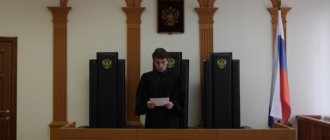ST 233 of the Criminal Code of the Russian Federation.
Illegal issuance or falsification of prescriptions or other documents giving the right to receive narcotic drugs or psychotropic substances is punishable by a fine in the amount of up to eighty thousand rubles or in the amount of the wages or other income of the convicted person for a period of up to six months, or by compulsory labor for a term of up to three hundred. sixty hours, or correctional labor for a term of up to one year, or restriction of freedom for a term of up to two years, or forced labor for a term of up to two years with deprivation of the right to hold certain positions or engage in certain activities for a term of up to three years or without it, or deprivation of freedom for a term of up to two years with or without deprivation of the right to hold certain positions or engage in certain activities for a term of up to three years.
Commentary to Art. 233 Criminal Code
1. The subject of the crime is: a) prescriptions written by medical professionals and giving the right to receive narcotic drugs or psychotropic substances (see Article 26 of the Federal Law of January 8, 1998 No. 3-FZ “On Narcotic Drugs and Psychotropic Substances”) ; b) other documents - documents that serve as the basis for the issuance (sale) of narcotic drugs or psychotropic substances and other actions related to their legal circulation. They may be: a license for a certain type of activity related to the trafficking of narcotic drugs or psychotropic substances; an application from a medical institution to receive these funds or substances for use in medical practice, an extract from the patient’s medical history, a waybill, etc. (Clause 33 of the Resolution of the Plenum of the Supreme Court of the Russian Federation of June 15, 2006 No. 14).
2. The objective side is expressed in the forgery or illegal issuance of prescriptions or other documents. The issuance of a prescription is illegal if there are no medical indications for its implementation or the established procedure for registration, regulated by Order of the Ministry of Health and Social Development of Russia dated February 12, 2007 N 110, is violated. Forgery may consist of making changes that distort the contents of the prescription or other document, or producing a completely false prescription or document.
3. To recognize the crime as completed, it does not matter whether the narcotic drug or psychotropic substance specified in the prescription or other document was actually received.
The right to treasure, consent to the search for which is given by the owner of the property
The treasure can also be discovered by a person who is not the owner of the property where the treasure was hidden.
If a treasure is discovered on someone else's land plot with the consent of the owner of the land plot to carry out work on the plot, including targeted excavations to find the treasure, the treasure is divided in equal shares between the person who is the owner of the property in which the treasure was discovered and the person directly who discovered the treasure (their shares in the right of common ownership of the treasure are equal).
This rule is dispositive: a different distribution of found property may be provided for by an agreement between the owner of the property and the person who discovered the treasure. Thus, they may decide that the treasure becomes the property of the person who has title to the property where the treasure was discovered; the treasure becomes the property of the subject who discovered the treasure; the treasure belongs to them by right of common shared ownership, but the shares are not equal, etc. An agreement can be concluded after the discovery of the treasure, and if there is a targeted search for it, even before this moment.
Second commentary to Art. 233 of the Criminal Code of the Russian Federation
1. The subject of the crime is a prescription or other document giving the right to receive narcotic drugs or psychotropic substances.
A prescription is a written order from a doctor drawn up on a standard form and containing all the necessary details for the issuance (and, if necessary, production) by a pharmacy of the specified medicine or drug containing narcotic or psychotropic substances, its composition and method of use.
Another document giving the right to receive narcotic drugs or psychotropic substances should be understood as documents that are the basis for issuing these drugs or substances. Such documents include, for example, an application from a medical institution to receive them, an extract from the medical history of an inpatient, etc.
2. Illegal issuance of a prescription means its preparation and delivery to a person who does not need to use drugs containing narcotic or psychotropic substances, or the indication in the prescription of an inflated amount of a drug that does not correspond to medical indications or the standard for one-time dispensing.
Illegal issuance of another document giving the right to receive narcotic drugs or psychotropic substances means the delivery of such a document to an individual or legal entity who does not have the right to receive it.
3. Forgery of a prescription or other document giving the right to receive narcotic drugs or psychotropic substances means either the production of a completely false prescription or other document similar to the real one, or the forgery of individual details of an authentic prescription or other document (for example, the recipient’s last name, date of issue of the prescription or other document, quantity of the drug, etc.).
4. The crime is recognized as completed from the moment the person is given a duly executed prescription for a drug containing narcotic or psychotropic substances, or a document giving the right to receive narcotic drugs or psychotropic substances, regardless of whether the specified drugs, drugs or substances were received by recipe or document. Receipt of narcotic drugs or psychotropic substances using a forged prescription or other document should be additionally qualified under Art. 228 CC.
5. Forgery of a prescription or other document giving the right to receive narcotic drugs or psychotropic substances is fully covered by the disposition of Art. 233 of the Criminal Code and does not require additional qualifications under Art. 327 CC. However, in cases where specified in Art. 233 of the Criminal Code, the actions were associated with the theft of a prescription issued in the prescribed manner or another document giving the right to receive narcotic drugs or psychotropic substances, the act must be qualified according to the totality of crimes provided for in Art. 233 and 325 of the Criminal Code.
6. The crime in question can only be committed with direct intent.
7. The subject of forgery of a prescription or other document giving the right to receive narcotic drugs or psychotropic substances can be any person who has reached the age of 16 years, and the subject of its issuance can only be a doctor or other person authorized to issue such documents.
Differences between a treasure and a find
Lost or hidden property . A treasure differs significantly from a find in that a treasure involves the deliberate concealment of things, and not their removal from the economic dominance of the rightful owner as a result of random circumstances. In other words, a find is a thing lost by the owner, and a treasure is property hidden (hidden) by the owner.
Any movable property or money and valuables . Treasure can only be money or other valuable items, and any movable thing is considered a find. That is, items that are not valuable are not considered treasure.
Property that has and does not have an owner . A find and a treasure differ in that the found thing usually has an owner, although most often it is not known who it is, and a treasure is formed by things that do not have an owner. In other words, a treasure is always ownerless things, the owner of which cannot be established or has lost the right to them.
Discovery of treasure by persons whose responsibilities include excavation and search for treasure
Rules clauses 1 and 2 art. 233 of the Civil Code of the Russian Federation do not apply if the person who discovered the treasure performed labor or official duties, which included excavations and searches aimed at discovering the treasure, that is, these persons do not have the right to claim ownership of the treasure and remuneration for it.
Since the search for things hidden in the ground or otherwise is part of the labor (official) duties of certain categories of workers (for example, an archaeologist), they receive remuneration for their work in accordance with labor legislation.
For employees who discover treasure, an additional bonus may be provided based on labor legislation. At the same time , the rules on treasure are inapplicable only if the search for treasure is included in the job duties , but if the treasure was discovered by an employee whose job function does not include the search for hidden values, for example a builder, the rules on acquiring ownership of the treasure and on remuneration for the transfer of the treasure that constitutes cultural values are disclosed in Article 233 of the Civil Code of the Russian Federation.
The right to treasure, the search for which was carried out without the consent of the property owner
If a search for a treasure or other actions that led to the discovery of a treasure were carried out without the consent of the owner of the property where the treasure was hidden, the owner of the property acquires ownership the treasure. That is, a person who discovers a treasure in someone else’s property or on someone else’s territory does not become a co-owner of the discovered money or valuable items.
At the same time, since the owner of the site acquires ownership of the relevant things, he can enter into an agreement with the person who discovered the treasure to transfer to him part of the things that make up the treasure, or to pay a reward for discovering the treasure. That is, an agreement between the parties may provide for the receipt of the treasure into common shared ownership; transferring it into the ownership of the person who discovered the treasure; transferring it into the ownership of the entity that owns the property where the treasure was discovered, with the payment of a certain reward to the person who discovered the treasure, etc.
Commentary on Article 233 of the Civil Code of the Russian Federation
1. Paragraph 1 of the commented article includes two legal norms. The first contains the definition of the treasure. The main thing in it is the indication that things that are treasure must be buried in the ground or hidden in some other way. These things, therefore, must at one time have been the object of volitional, purposeful activity to conceal them. There are both similarities and differences between a treasure and a find (Article 227 of the Civil Code): in both cases, a thing is discovered. However, in the case of a treasure, we are talking about the discovery of something that was specifically hidden.
The time that elapses between the concealment of a thing and its discovery does not matter. Hiding a thing can be done as long ago as desired. On the other hand, if the thing was not hidden, then it is not a treasure, no matter how much time passes before its discovery. For example, there is a known case when one of the ancient Russian princes lost his helmet in an internecine battle, which was found lying on the surface of the earth 500 years later. If its discovery had occurred during the period of the commented article, it could not be recognized as a treasure. Similar facts occurred in other countries. In particular, in Great Britain, precious objects that were lost by ancient Roman soldiers have recently been discovered (in one case at the bottom of a river, and in another in a former barracks latrine).
The second point in the definition of treasure contained in paragraph. 1, paragraph 1 of the commented article, is an indication that an item is recognized as treasure if it is money or valuable items. The law does not establish any limiting characteristics in relation to both categories of things.
The third point is to indicate that the owner of the relevant items cannot be identified. The question of who makes this determination is left open. We only note that the Civil Code uses the term “establishment” here, which indicates the official nature of the corresponding conclusion.
The fourth point is the requirement that the owner of hidden things lose the right to them, and lose it by force of law. Here, too, the question is left open, although enforcement is mentioned.
2. The second legal norm contained in paragraph. 1 paragraph 1 of the commented article regulates the issue of acquiring ownership of a treasure. This issue has not been completely resolved.
The situation when the treasure was discovered by a person who has ownership rights to the property in which it was hidden was left unattended. When resolving this issue, one should rely on para. 2 clause 1 of this article. If, when a treasure is discovered by a person who does not have the consent of the owner of the property, the right of ownership to the treasure is acquired by the owner of the property in which it was hidden, then even more so the right of ownership belongs to him if he himself discovered the treasure.
3. The special rule contained in paragraph. 1 paragraph 1 of the commented article regulates another situation, namely the case when the treasure was discovered by a person who is not the owner of the land plot or other property where the treasure was hidden. In this case, the right of ownership to it is acquired by two persons: the person who is the owner of the said property, and the person who discovered the treasure. Thus, the treasure becomes their common shared property (clause 2 of Article 244 of the Civil Code), and their shares are equal. This decision has deep historical roots. This is how this issue was resolved in Ancient Rome since the time of Emperor Hadrian. However, the Civil Code allows for another solution to the issue by agreement of the owner and the person who discovered the treasure.
The Civil Code speaks of the discoverer of the treasure as a person. The concept of a person is determined by the norms of subsection. 2 “Faces” section. I “General Provisions” of the Civil Code. The finder of the treasure can be not only an individual, but also a legal entity.
As for the other participant in the common shared ownership of the treasure, then par. Paragraph 1 of the commented article refers to the person who owns the property. A thing belongs to the person who has ownership rights to it. This should be kept in mind since the Civil Code directly refers to the land plot. The latter belongs neither to the one who has the right of lifelong inheritable ownership, nor to the one who has the right of permanent (perpetual) use.
4. The rule established by paragraph. 2 paragraph 1 of the commented article follows from paragraph 3 of Art. 261 of the Civil Code, which provides that the owner of a land plot has the right to use at his own discretion everything that is above and below the surface of this plot. Accordingly, he has the right to give consent to other persons to search for treasure on his site. The same right belongs to the owner of other types of property where treasure may be hidden (Article 209 of the Civil Code). Accordingly, this rule establishes that in cases where the search for treasure was carried out without the consent of the owner of the property, the ownership of the treasure belongs to the owner of the relevant property. This norm is imperative.
The Civil Code authorizes, in particular, the owner of the land plot to give consent. Therefore, neither the subject of the right of lifelong inheritable possession, nor the subject of permanent (perpetual) use has such a right.
5. Turning to para. 1 paragraph 1 of the commented article, we note that it contains two legal norms. The first regulates the acquisition of ownership rights to things of a special kind, namely things included in the treasure and representing a historical or cultural monument.
First of all, we note that in this case the object of legal regulation is the treasure (or part of it), i.e. thing, the definition of which is given in paragraph. 1 paragraph 1 of the commented article.
In addition, para. Paragraph 1 of paragraph 2 of the commented article requires that the thing be classified as a historical and cultural monument. It should be emphasized that the law uses the term “monument”. In its content, the concept of a cultural monument is much narrower than the concept of cultural value used both by the Civil Code itself (Article 240) and part 3 of Art. 4 of the Federal Law of April 15, 1998 N 64-FZ “On cultural values moved to the USSR as a result of the Second World War and located on the territory of the Russian Federation” (as amended on August 22, 2004) <1>.
——————————— <1> NW RF. 1998. N 16. Art. 1799; 2000. N 22. Art. 2259; 2004. N 35. Art. 3607.
On the other hand, paragraph 2 of the commented article deals with such things related to historical and cultural monuments, which, due to their physical characteristics, have the ability to be hidden in other property. For this reason, the concept of a historical or cultural monument, used by Art. 233, differs from the concept of the same name used by the Federal Law of June 25, 2002 N 73-FZ “On objects of cultural heritage (historical and cultural monuments) of the peoples of the Russian Federation” (as amended on December 31, 2005) <1>, which refers to monuments history and culture of individual buildings, buildings and structures, ensembles (i.e. historically established groups of buildings), works of landscape architecture and places of interest (Article 3).
——————————— <1> NW RF. 2002. N 26. Art. 2519; 2003. N 9. Art. 805; 2004. N 35. Art. 3607; 2005. N 23. Art. 2203; 2006. N 1. Art. 10.
6. Regulating the issue of acquiring the right of ownership of things contained in a treasure belonging to historical or cultural monuments, paragraph 2 of the commented article establishes that the right of ownership is acquired by the state. However, he uses the unfortunate expression “subject to transfer into state ownership,” which can be understood in the sense that as a result of discovery, the treasure becomes the property of someone else, who is obliged to transfer it. In fact, this case of acquisition by the state of property rights is one of the initial, rather than derivative, methods of acquiring property rights.
This norm considers state property in general terms, while it is divided into federal state property and state property of the constituent entities of the Russian Federation. Regulations on the accounting, assessment and disposal of property converted into state ownership, approved by Decree of the Government of the Russian Federation of May 29, 2003 N 311 <1> “On the procedure for accounting, assessment and disposal of property converted into state ownership”, which determines the further fate of things included in the composition of treasures and acquired by the state into ownership by virtue of clause 2 of the commented article establishes that it is transferred to the Ministry of Culture of Russia (its territorial body for the preservation of cultural property) (clause 2 “b”).
——————————— <1> NW RF. 2003. N 22. Art. 2171.
7. Paragraph 1 of clause 2 of the commented article also regulates the case when a treasure containing things related to historical and cultural monuments was hidden in property belonging to one person, but was discovered by another person. It has been established that both of these persons have the right to receive a joint reward in the amount of 50% of the value of the treasure. This remuneration is distributed between them in equal shares. The last norm is dispositive.
By virtue of this rule of the commented article, an obligation arises. One party to this obligation is two persons: the person who discovered the treasure, and the owner of the land plot or other property where the treasure was hidden. The right to remuneration has the person who has the right of ownership of the land plot, including the relevant municipality, as well as the state itself (if the treasure was found on state land).
A significant drawback of the commented article is the absence of a direct reference to the other party in the obligation, namely the party obligated to pay the remuneration. One can, of course, conclude that since the state acquires property rights, it is a party to the obligation. But the main question remains open: which government body is obliged to pay the reward? This is not indicated in Regulation No. 311 dated May 29, 2003. Such a gap in the legislation on this key issue can ultimately harm the preservation of historical and cultural monuments.
There are other gaps as well. In particular, the question of what to do in cases where the owner of the property in which the treasure was hidden is the Russian Federation itself or a subject of the Russian Federation has not been resolved.
8. Paragraph 3 of the commented article establishes that the rules contained in its paragraphs 1 and 2 do not apply to certain persons. Their activities are regulated by the Federal Law “On objects of cultural heritage (historical and cultural monuments) of the peoples of the Russian Federation.” It establishes that individuals and legal entities who carried out archaeological field work are obliged, within 3 years from the date of completion of the work, to transfer all discovered cultural values for permanent storage to the state part of the Museum Fund of the Russian Federation (clause 9 of Article 45). This obligation also applies to treasures discovered by them, including those related to historical and cultural monuments.
9. From the above it is clear that the commented article is not without significant shortcomings. Even more important, many of its norms are not sufficiently linked to the rules of civil procedure.
As noted, the commented article in a number of its rules presupposes certain judicial acts. Sometimes this is done almost directly, in particular when the Civil Code requires that it be established that the owner of hidden things by force of law has lost the right to them, or that their owner be identified. In other cases, the Civil Code indirectly assumes the participation of the courts, for example, when deciding whether a treasure belongs to historical or cultural monuments.
Meanwhile, the Code of Civil Procedure, which established a closed list of cases considered in special proceedings, did not include cases of treasures in it (clause 1 of Article 262). This is a significant gap. As foreign practice in countries with developed market economies shows, treasure cases can give rise to complex disputes.







